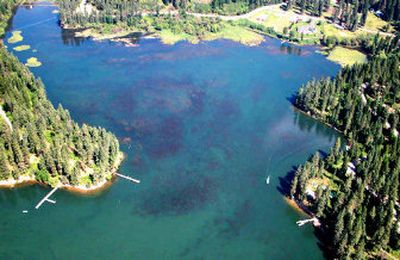Milfoil found in three more lakes

The more they look, the more they find.
In recent weeks, Eurasian milfoil has been confirmed in Priest Lake, in addition to two other North Idaho lakes, Cave and Medicine. Experts say they aren’t surprised by the new discoveries – the exotic weed easily hops between lakes by hitching rides on boat propellers and trailers.
Each of these additional infested lakes means more work for weed control agencies in the midst of a $4 million statewide milfoil eradication mission.
“There was definitely more than we knew of,” said David Lamb, lake ecologist for the Coeur d’Alene Tribe and chairman of Idaho’s milfoil task force. “I had a feeling once we started looking we’d start finding it.”
Despite the discoveries, Lamb and other weed warriors remain hopeful the unprecedented infusion of funding this summer can knock milfoil back to controllable levels. Some lakes already are showing signs of reduced weeds, thanks to the recent application of herbicides and hand-pulling by divers.
Nearly 300 acres on Hayden Lake have been treated with herbicides containing the active ingredients 2,4-D or triclopyr. Aerial surveys conducted last week show the weed is beginning to disappear from shallow bays. Last year, some bays were impassable because of thick, tangled mats of milfoil.
“Hayden is looking extremely good,” said Nina Eckberg, Kootenai County weed superintendent.
Scuba divers also are pulling weeds in about 10 acres of the lake, Eckberg said. The county is following up the treatments with aerial and underwater surveys. Additional herbicide treatments also are expected later this summer.
The recent discovery of about 100 acres of milfoil in Cave and Medicine lakes – located on a chain of lakes about 20 miles southeast of Coeur d’Alene – had Eckberg scrambling earlier this week to apply for special funding from the state to pay for treatments. A similar effort is under way for Priest Lake.
Officials hope to pull or poison the milfoil before the water cools. Once the growing season ends, the plant undergoes a reproductive process known as auto-fragmentation, where it essentially shatters, sending plant pieces throughout the lake. These small pieces can take root in the mud and mature the following season.
Weed removal is beginning this week at the southern end of Lake Coeur d’Alene, as well as waterways in Bonner County. The Coeur d’Alene Tribe is using a combination of divers and herbicides to remove weeds from about 330 acres on Chatcolet and Round lakes. Divers will be working for the next two weeks to suction weeds from the bottoms of the lakes, Lamb said.
So far most of the tribe’s work has focused on the east shore of Lake Coeur d’Alene, which appears to have the thickest infestation of weeds, Lamb said. Prevailing winds tend to blow the weed fragments onto that shoreline, he said.
The tribe hasn’t yet conducted a detailed survey of the west shore. Because of all the weed control work going on across the Panhandle this summer, “divers are in short supply,” Lamb explained.
Herbicide treatment and hand-pulling is scheduled to begin the week of Aug. 14 for Spirit Lake. For five years, the lake’s property owners association has conducted an ambitious effort to remove the weed from the lake, but patches remain, including near the large island on the west end of the lake.
“It’s just a matter of keeping on top of it,” said Lisa Pendleton, with the property owners association. “At this point we don’t know if we can eradicate it, but we’re going to give it a try.”
Property owners around Spirit Lake have been eager to donate money to control the weed, as well as pull weeds from shallow areas, Pendleton said, adding, “Milfoil could ruin the lake.”
Once the weed takes root, it can crowd out native plants. Thick mats of milfoil can also entangle swimmers and are a hazard for boats. When the plants die and decompose in the fall, they rob oxygen from the water.
This week, Bonner County is expected to begin herbicide treatments in Lake Pend Oreille’s Denton Slough. County officials believe a quarter of the slough is choked with weeds, though conservation groups have disputed the claim, saying few milfoil plants were found during a recent survey. The groups worry the use of chemicals will only hurt native plants and wildlife.
Follow-up monitoring on Hayden Lake has shown little harm to native aquatic plants from chemical treatments applied the end of June, said Eckberg. The herbicide 2,4-D has the same active ingredient used to kill dandelions. “We haven’t seen any issues with native plant dieback,” Eckberg said.